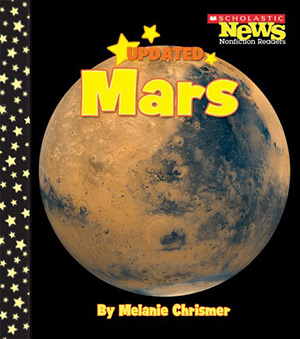Category: Children’s Book
Reviewed by: Marianne Dyson
Title: Mars (Updated Edition)
Author: Melanie Chrismer
Ages: 4-8
NSS Amazon link for this book
Format: Hardcover
Pages: 24
Publisher: Children’s Press (Scholastic)
Date: March 2008 (originally 2005)
Retail Price: $6.95
ISBN: 0531147622
New readers will find the short, large-print Mars (Updated Edition) by Melanie Chrismer a book that they can read by themselves with confidence. Each of 7 spreads presents facts about Mars using simple declarative sentences. Art and photos illustrate the facts.
This book does not require any prerequisite knowledge. For example, the book opens by explaining that some bright objects in the night sky are not stars. Adults often forget that young children do not already know these things. Discovering this fact for themselves by reading it in a book will provide great motivation for reading more books! (Parents may want to check the position of Mars in the sky prior to giving their children this book, so they can answer the inevitable “where-is-it” question!) Fortunately for these eager new readers, Mars is part of a series that includes all the planets, the Moon, and the sun. Libraries are likely to have the whole set by this author.
Page 9 shows the sun and 6 planets in order — illustrating the fact that Mars is the fourth planet from the sun. The disks of Mercury, Venus, Earth, and Mars are in approximate scale to each other, but Jupiter and Saturn are not. (Jupiter is 11 times the diameter of Earth, and Saturn is 9.5 times bigger.) The sun’s arc is not to scale, either (109 times Earth’s diameter). At this level, though, I agree with the publisher’s decision not to use the exact scale, but to focus on the important fact that Mars is the fourth planet, and is larger than Mercury and smaller than all the others.
The spread on pages 20-21 shows the orbits of the planets. Apparently, Pluto was removed in the update of this book, so that only 8 planets are labeled. However, the orbit line for Pluto remains on the drawing and may confuse a few eagle-eyed future engineers.
Teachers and parents will appreciate the seven new vocabulary words listed at the front with pronunciation guides, such as rover (roh-ver) and astronomer (uh-stron-uh-mur). These words are defined in a glossary at the back. A handy comparison of Earth and Mars is also provided in the back. This placement should help reinforce and integrate the new knowledge the child has learned about Mars.
The last page recommends only one book and one Web site to find out more. The book is Mars by Darlene Stille. I could not find any reviews of this book, published in 2003, but it is listed for ages 9-12, which would be the next level up. The recommended Web site is no longer up.
Finally, I had to smile when I read the “Meet the Author” note. I met Melanie (who now lives in Georgia) years ago through the Houston chapter of the Society of Children’s Book Writers and Illustrators (SCBWI). When I once flew on NASA’s parabolic aircraft (a.k.a. the “Vomit Comet”), I met a college team that needed a journalist to fly with them. I immediately thought to recommend Melanie, knowing that she shared my love of space science. Her author note includes a reference to the resulting flight, which she calls “the best roller coaster ever!”
Mars is a great first introduction to the red planet for new readers.
© 2009 Marianne Dyson
Please use the NSS Amazon Link for all your book and other purchases. It helps NSS and does not cost you a cent! Bookmark this link for ALL your Amazon shopping!



















